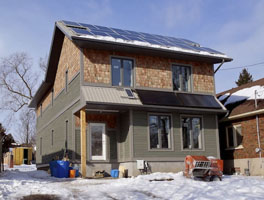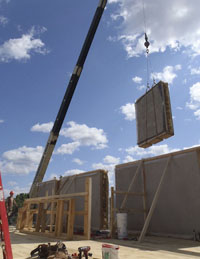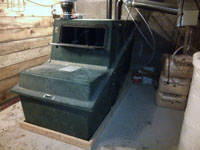Low-Tech, High-Tech House…And Extremely Green
By Wendy Priesnitz
Two kinds of straw bale wall, passive and active solar, state-of-the-art building techniques and materials, and high-tech monitoring create an extremely green and healthy house on an urban infill lot.

Photo © Endeavour Centre |
If you could build a house that has a fraction of the environmental impact of a conventional home but is affordable, comfortable, and healthy for its occupants, reproducible by other builders, and fits in well with its neighbors in an existing older urban neighborhood… would you consider it trendsetting?
Such a house was built in 2012 by students and staff at The Endeavour Centre, a not-for-profit sustainable building school in Peterborough, Ontario. Says the Centre’s co-founder Chris Magwood, “We figured that if we can achieve all of these goals, then the project has real value as a potential trendsetter.”
In fact, the builders have dubbed it “Canada’s Greenest Home” and that might not be hyperbole. Every aspect of the home was designed, sourced, and built to meet the highest possible environmental standards. Along the way, a number of green and healthy building rating systems were used as models and guides, including Living Building Challenge, LEED, Building Biology, Energy Star for Homes, EnerGuide.
In some cases, such as sourcing wood, decisions were made above and beyond those standards. For instance, for the purposes of the Living Building Challenge, and, as Magwood puts it, “as a responsible builder trying to make good choices,” the lumber for the subfloor would be certified by the Forest Stewardship Council (FSC). However, that product would have had to be imported from Oregon and still contained phenolic formaldehyde. So they ended up decking the floor with locally milled pine 1x8s. It’s not FSC certified, but it comes from a family-owned sawmill, which buys all its logs from the local area (within a 100 mile radius of the mill). Magwood says, “Rather than just using a ‘greener’ version of a conventional product, sometimes the better answer is to change practice altogether.”
Much of the attention in a sustainable building goes to the high tech equipment and mechanical systems. But this house is a seamless combination of low- and high-tech. For instance, two types of straw bale construction – prefabricated straw bale panels and on-site constructed straw bale – are used for the exterior walls. The prefab wall units are made by NatureBuilt Wall Systems and called Bio-SIPs. They are largely identical to the load-bearing straw bale walls that have been used since the first straw bale buildings were constructed in the late 1800s. But rather than building them by stacking bales vertically and plastering in several coats, they are built in a shop space and plastered while lying horizontally. This greatly reduces the amount of labor and wooden framing involved, and ensures walls of consistent strength and size. During a “field trip,” the class experienced the entire construction process for the panels and helped build nine of the twenty-four panels used in the house.

Prefab straw bale panel being lifted into place - Photo © Endeavour Centre |
The north (back) wall of the house uses straw bales in a more conventional way. The bales are installed into a double frame wall system that mimics conventional frame walls, but with the studs placed at thirty-four inches on center. That creates “bays” in the wall that are sized to the length of the bales, making bale stacking and plaster preparation simple and straightforward. “Installing the straw bale walls on the north side of our building and coating them in clay plaster is a strategy that combines low cost with high performance, and provides a window to a building system that is competitive with current energy-intensive practices but is also feasible in a world with a lot less fossil fuels to expend.” They are covered with a “two-part, once-coat” clay plastering system.
|
At a Glance:
- Urban infill siting
- Regionally and ethically sourced renewable building materials
- Prefabricated straw bale wall panels
- Net zero energy use, featuring photovoltaic electricity and solar hot water
- Home energy monitoring and programmable dashboard
- Zero emissions Air Source Heat Pump for heating and cooling
- Energy Recovery Ventilation (ERV) system
- Full rainwater harvesting and treatment
- Complete composting toilet system
- All non-toxic materials and finishes, including milk paint, clay plaster |
The house combines both active and passive solar. One of the south facing roof surfaces holds the solar hot water heating system: two collectors and a small PV module. It will provide between fifty and seventy-percent of the home’s hot water needs. It’s paired with a very large storag tank and an electric on-demand heater.
The house itself is heated using a Mitsubishi Zuba air source cold climate heat pump installed on the exterior of the house. These units are able to make usable heat at temperatures as low as -30C, making them feasible as the sole heat source for a northern climate home as long as the home is made to be energy efficient. As with all heat pumps, the Zuba can run in reverse and be an efficient air conditioning unit in the summertime.

Tank of the Clivus Multrum composting toilet tank system
Photo © Endeavour Centre |
The home’s energy needs are taken care of by a five-kilowatt photovoltaic system mounted on the upper south-facing roof. These panels generate electrical power that should, over the course of a year, equal the annual energy consumption of the building.
A few parts of the house don’t have straw bale walls in order to demonstrate to the students a more mainstream way to achieve high energy efficiency with low environmental impact: double stud framing and dense-packed, blown-in cellulose insulation. These sections of the building are framed with 2x4s and are the same depth (fourteen inches) as the bale wall cavities. The insulation is made from shredded, recycled newspaper and borax.
Below-grade insulation is based on a product called Poraver, which are expanded glass balls made from recycled glass. Like perlite, they are a lightweight, mineral-based insulation but stronger and less dusty, and don’t involve the mining of virgin resources. They were bound together using a mixture of hydrated lime and a material called Metapor – a kaolin clay that has been fired at high temperatures.
The crawlspace foundation is made with Durisol blocks. Durisol is an insulated concrete form (ICF) that uses waste wood chips in a cement slurry to form large blocks with an integral Roxul insulation insert. These blocks create a wall with an R-28 insulation value. The blocks are dry stacked and a grid of rebar is placed in them, both horizontally and vertically, and the open channels inside the blocks are poured with concrete.
A building’s energy performance is contingent on good sealing to ensure that the opportunities for air leakage are minimized. Continuous barriers running behind the plaster at the edges of each straw bale and tied into barriers at the ceiling, floor, and doors and windows, help prevent leakage through the outer walls. The bottom plates of the prefab bale walls feature an air control membrane that is embedded under the plaster skin and extends over the wooden bottom plate. The air barrier membrane from the foundation ties in behind the barrier from the wall, and the two are taped together at the seam. A similar treatment is used at the top plate of the prefab walls, and where two panels intersect.
A high level of indoor air quality results from the all-natural finishes that have been used. The flooring in much of the house is FSC-certified hardwood. The pine ceilings on the main floor have been whitewashed using a homemade mixture of Casein powder, water, and powdered hydrated lime.
Another important feature of the house, from an environmental viewpoint, is the Clivus Multrum M10 chamber-style composting toilet system.
Learn More
www.endeavourcentre.org
|

